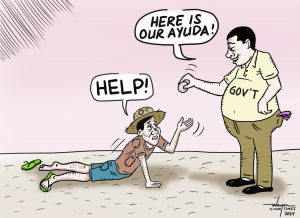 In the last eight months of the existence of the present City Council, we have yet to hear a proposed ordinance introduced by a member or passed by the local lawmaking body that has of significant impact on the people of the city or the local government unit itself.
In the last eight months of the existence of the present City Council, we have yet to hear a proposed ordinance introduced by a member or passed by the local lawmaking body that has of significant impact on the people of the city or the local government unit itself.
Yes, we have been praying that someone, especially from the new and young members, to introduce in the body such local laws that seek to address the clearly deteriorating environmental situation in the city; or something that will enhance the city’s development program by its terrain and population growth.
For now, the city’s urban center continues to attract more people because most of the jobs available are in establishments located in the city’s central business district (CBD). Naturally, it follows that the agglomeration of informal settlers’ colonies continues to squeeze into whatever little spaces there are in the city even if it would mean encroaching into some privately-owned properties.
Then every Davaoeno became witness to the slow but sure diminution of the remaining productive farmlands of the city starting in the late seventies. And come the opening and expansion of several corporate farms planting exportable variety bananas, pineapple, and even pomelos. Next was the coming of the residential subdivision era when developers were in strong competition to grab every available square meter of land suitable for house construction be it in the lowland plains or the highland slopes.
Of course, the City Council some years back took cognizance of the need to relocate health-threatening industries like poultry and swine farms. So the body amended the Zoning ordinance to designate new sites for the foul-odor=emitting farms. But the amendment merely shifted sufferers from those in the suburbs to the rural residing population.
But as they say, development is a continuing process may this be fast or slow. That is why any observant Davaoeno will notice that new economic enclaves are rising not only in the peripheries of Davao City’s CBDs but also in its administrative districts. However, other than the amenities provided in the Zoning Ordinance, we have yet to hear of other local laws that call for projects that will complement what are provided or allowed in the earlier-mentioned zoning law.
For example in Calinan proper where new structures are rising to accommodate the space requirement of new businesses, what used to be farmlands that can gulp huge volumes of rainwater are gone after these were virtually dumped with aggregates for the huge structures to locate. Some areas are also converted into memorial parks and residential subdivisions. So where else will the excess rainwater go but directly to the highways converting the same to instant rivers when rains fall so hard and long.
Meanwhile, we have yet to see a new drainage project or even an expansion of existing canals leading to the main waterways. For certain such drainage improvement projects will lessen the chances of flooding the main roads in the Calinan central area.
This may also be true in the newly rising economic enclaves of the city’s other districts. And similarly, the City Council may have also failed to look into what could be the more appropriate projects to address potential problems that could be brought about by the onset of development.
Say the health hazard to rural community residents where new and transferred poultry and hog farms are located. There was a time when the previous Council through then Chair Dr. Joselle Villafuerte of the Health Committee came up with a palliative solution to the swarm of flies invading houses in the farm’s immediate vicinity. And that was to encourage (not to comply with any ordinance) poultry and hog farm owners to provide residents affected with flies chemical repellants. So how could a such solution be sustainable when the provision of the chemical is only at the discretion of the poultry and hog farm operators?
And if none of the present council members could think of a new significant ordinance to be introduced in the local lawmaking body, how come the councilors haven’t thought of tapping any or some of its staff members to research existing ordinances that could be amended to include provisions that will address certain nagging problems of the city and its people?
If we remember right one past Council came up with an ordinance banning the use of non-recyclable plastic as wrappers or containers of merchandise bought in wet markets, grocery, and department stores. But compliance with the said ordinance is only observable in the last two store categories, not in public wet markets. Of course, the reason behind the religious compliance of that anti-plastic ordinance by mall-based groceries and department stores is one strategic decision. It is another business opportunity to sell reusable bags instead of plastic to customers.
Perhaps the present Council can learn some lessons from the City of San Carlos in Negros Occidental. From the experience of other people who have had the opportunity to visit and stayed for some time in that city that was shared with us, it appears that the non-use of plastic in almost every business and even in the household, has already become a matter of habit to the people of the city.
In our beloved Davao City, there is no denying the fact that much has yet to be done just to reach the level of substantial compliance with the non-use of the plastic ordinance. One, including any of our Honorable Council members, needs only to take a look at the city’s drainage canals and rivers to affirm our observation.
Come on Honorable Gentlemen and Ladies. For once, get up from your swivel chairs. Take your comfortable service vehicles and visit the areas of your respective constituents. For sure you can get many inputs that you need to think of possible ordinances that can be more meaningful to them. We think it is already enough with introducing resolutions and similar documentation gobbledygook.
-30-
.


